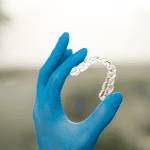
Dental bruxism, which is often triggered by stress, is the medical term used to describe habitual clenching or grinding of the teeth and jaw. Stiff or fatigued jaw muscles when you wake in the morning, headaches, neck aches, sensitive teeth, jaw pain, noises when opening or closing your mouth; all of these can be signs of dental bruxism and TMJ disorder.
So your dentist tells you that you’re clenching your teeth. What now?
A wide variety of treatments exist for bruxism and TMJ (Temporo-Mandibular Joint) pain, some more effective than others. Choosing the right treatment for you is an important decision that you and your dentist should make together after considering all factors and treatment options.
What are my treatment options?
Traditional methods of treatment, such as night guards, occlusal splints and behavioral therapy may be the right choice for some cases, but these options have definite limitations and drawbacks.
Mouth guards only work when you wear them, and people don’t like to wear them. Pick a reason, there are many (they make me gag, look gross, I can’t sleep, less than flattering, I travel often)”¦ In my experience, in the real world, many people don’t wear them.
The newest emerging treatment involves attempting to change the behavior by treating the muscles that are actually causing the problem; thereby solving the problem, not just treating the symptoms of this problem.
Increasingly, injectable therapies are being adopted as a preferred, safe alternative for treating bruxism, TMJ disorders, migraine headaches, etc. Using what we call localized muscle infusion techniques, we can painlessly inject a muscle-relaxing compound directly into the muscles that are doing the most damage, and in doing so we can treat your bruxism without the use of cumbersome mouth guards. And it works; all day, everyday, whether asleep or awake; home, work or gym, it’s always working for you.







